Input interpretation

valeraldehyde
Chemical names and formulas
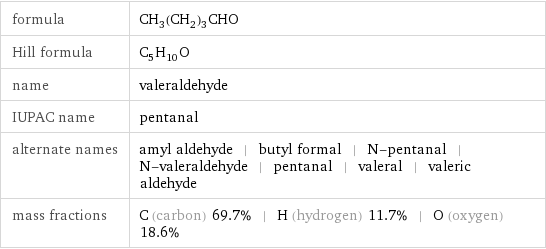
formula | CH_3(CH_2)_3CHO Hill formula | C_5H_10O name | valeraldehyde IUPAC name | pentanal alternate names | amyl aldehyde | butyl formal | N-pentanal | N-valeraldehyde | pentanal | valeral | valeric aldehyde mass fractions | C (carbon) 69.7% | H (hydrogen) 11.7% | O (oxygen) 18.6%
Lewis structure
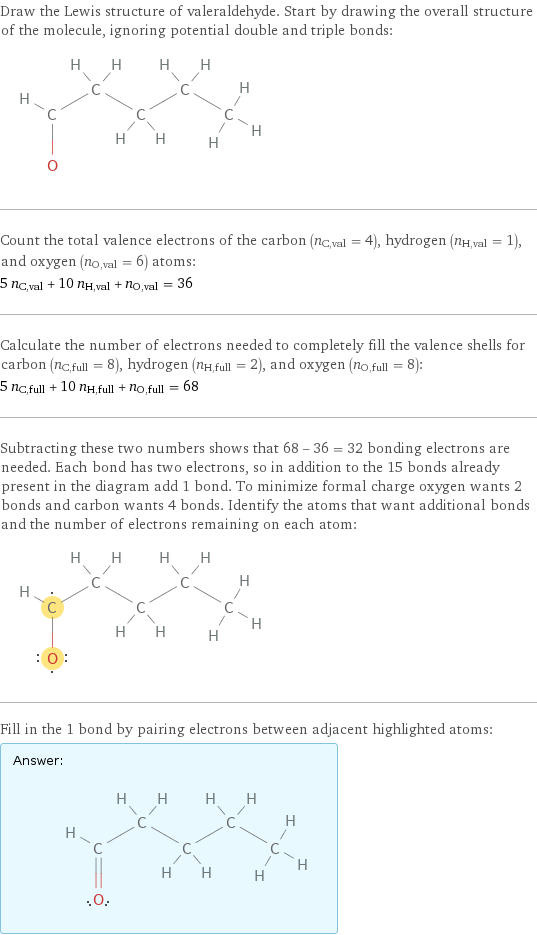
Draw the Lewis structure of valeraldehyde. Start by drawing the overall structure of the molecule, ignoring potential double and triple bonds: Count the total valence electrons of the carbon (n_C, val = 4), hydrogen (n_H, val = 1), and oxygen (n_O, val = 6) atoms: 5 n_C, val + 10 n_H, val + n_O, val = 36 Calculate the number of electrons needed to completely fill the valence shells for carbon (n_C, full = 8), hydrogen (n_H, full = 2), and oxygen (n_O, full = 8): 5 n_C, full + 10 n_H, full + n_O, full = 68 Subtracting these two numbers shows that 68 - 36 = 32 bonding electrons are needed. Each bond has two electrons, so in addition to the 15 bonds already present in the diagram add 1 bond. To minimize formal charge oxygen wants 2 bonds and carbon wants 4 bonds. Identify the atoms that want additional bonds and the number of electrons remaining on each atom: Fill in the 1 bond by pairing electrons between adjacent highlighted atoms: Answer: | |
3D structure
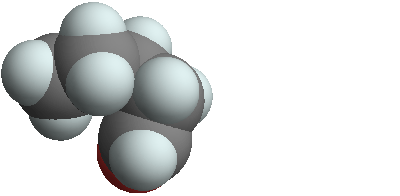
3D structure
Basic properties

molar mass | 86.13 g/mol phase | liquid (at STP) melting point | -92 °C boiling point | 102.5 °C density | 0.81 g/cm^3 solubility in water | slightly soluble
Units

Hydrophobicity and permeability properties

predicted LogP hydrophobicity | 1.41 predicted LogS | -0.76
Basic drug properties

approval status | experimental | small molecule
Liquid properties (at STP)
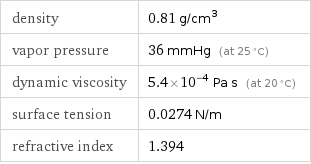
density | 0.81 g/cm^3 vapor pressure | 36 mmHg (at 25 °C) dynamic viscosity | 5.4×10^-4 Pa s (at 20 °C) surface tension | 0.0274 N/m refractive index | 1.394
Units

Thermodynamic properties

specific heat of formation Δ_fH° | gas | -2.652 kJ/g molar heat of formation Δ_fH° | gas | -228.4 kJ/mol molar heat of vaporization | 34 kJ/mol | specific heat of vaporization | 0.395 kJ/g | molar heat of combustion | 3071 kJ/mol | specific heat of combustion | 35.65 kJ/g | critical temperature | 554 K | critical pressure | 3.5 MPa | (at STP)
Chemical identifiers

CAS number | 110-62-3 Beilstein number | 1616304 PubChem CID number | 8063 PubChem SID number | 24846963 SMILES identifier | CCCCC=O InChI identifier | InChI=1/C5H10O/c1-2-3-4-5-6/h5H, 2-4H2, 1H3 InChI key | HGBOYTHUEUWSSQ-UHFFFAOYAJ RTECS number | YV3600000 MDL number | MFCD00007026
NFPA label

NFPA label
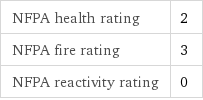
NFPA health rating | 2 NFPA fire rating | 3 NFPA reactivity rating | 0
Safety properties

flash point | 12.22 °C autoignition point | 220 °C lower explosive limit | 1.7% (concentration in air) upper explosive limit | 6.8% (concentration in air)

DOT hazard class | 3 DOT numbers | 2058
Toxicity properties

threshold limit value | 50 ppmv

RTECS classes | mutagen | primary irritant